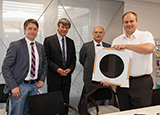Mayor of Dresden Dirk Hilbert treated to a full rundown

Fraunhofer IZM’s All Silicon System Integration Dresden (ASSID) center is celebrating its two-year anniversary. With a steadily expanding team of researchers and technical support staff that currently numbers 33, ASSID has evolved into a leading center for 3D microsystem integration. To mark the occasion, ASSID gave Dresden Mayor, Dirk Hilbert, an on-site overview of the center and its work.
Highlights included the completion of a 300 mm 3D system integration processing line. The assembly is a first for Germany and the Fraunhofer Gesellschaft, providing a one-stop processing line for development and prototyping of 3D wafer-level system in packages (WL-SiPs).
Funded by the German federal ministry of education and research (BMBF), the Land Saxony and the EU, ASSID is at the forefront of 3D system integration internationally.
Having established itself as the go-to address for 3D system integration, the center is currently working with more than 40 domestic and international companies in a variety of project models. Examples include cooperation with Globalfoundries in Dresden and the companies Infineon Technologies and NXP. As part of joint development agreements, the center is also working towards crucial technology advancements with leading tool manufacturers, including Applied Materials, SPTS, Oerlikon, EVG and Suess Microtec. Research projects are also underway with TU Dresden, TU Chemnitz and TU Berlin.
Over the last two years, ASSID’s researchers have been developing new processes for almost every area of 3D wafer-level system integration, which is a key approach in microelectronics and microsystem technology. The center develops techniques for integrating multiple electronic components, such as processors, memory or sensors, into single systems housed in minute build spaces.
As tiny, energy-efficient and highly electronic systems, WL-SiPs are used in a wide range of areas, including medical devices, safety and security, automation and automotives. Because the systems are designed as modular elements, they are ideal for meeting non-standard application requirements and customer requests, reducing time-to-market and improving cost-efficiency.
Last modified:
 Fraunhofer Institute for Reliability and Microintegration IZM
Fraunhofer Institute for Reliability and Microintegration IZM